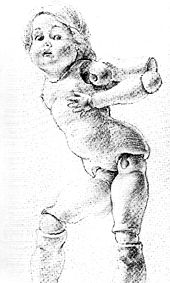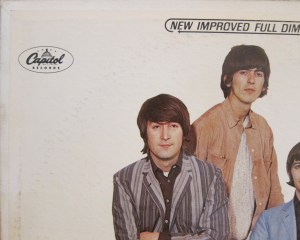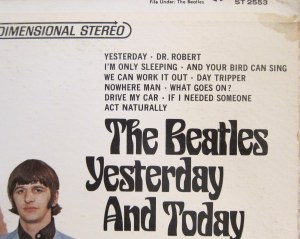
It was very confusing being an American Beatles fan in the sixties. Apparently. I have the disadvantage from a perspective point of view of a) being British and b) having been born in 1970…
In the years up to 1966, Capitol in the USA had a rather cavalier attitude to albums. Rather than promoting them as statements of Art by Artists, they favoured a strategy of maximising the amount of product (and thus cash) they could get, by callously cutting tracks off completed albums and holding them back.
Whilst I have some sympathy with this (there’s a couple of Red Hot Chilli Peppers albums that I would take the surgeon’s knife to pretty strongly for example), when it comes to The Beatles this seems to have been a pretty cynical approach.
So whilst The Beatles released 14 songs per album on some UK releases, and frequently left singles off albums, Capitol kept the tracks down to ten or eleven per album, kept those album tracks back, added some singles and B-sides and converted them into more “new” albums. Thus US albums include titles unheard of the in UK such as “Something New”, “Beatles ’65” “The Early Beatles“, “Beatles VI” and finally “Yesterday…And Today”.

It also means that a US issue of Revolver has only eleven songs, missing out “I’m Only Sleeping”, “And Your Bird Can Sing” and “Doctor Robert” – all coincidentally John Lennon’s songs. Why? Because all of these had been sent across to the USA to appear on the mish mash of Yesterday…And Today, alongside Rubber Soul songs “Drive My Car”, “Nowhere Man”, “If I Needed Someone” and “What Goes On”, plus Help’s “Yesterday” and “Act Naturally”. With the addition of already released single “Day Tripper” / “We Can Work It Out”, Capitol figured they had another money making Beatles album to release to the American public.
However Yesterday…And Today remains the only album Capitol actually initially lost money on, despite the fact that it topped the charts for most of the summer of 1966. The reason was because of the cover, which has since become the most sought after and collectible Beatles album.
On a recent US holiday, I picked up a copy of the album, so here’s the story:
The cover originated from a photo shoot with photographer Robert Whitaker and featured the Fab Four posing with huge smiles and butcher’s coats holding slices of meat and beheaded dolls. It’s an extraordinary photo, especially considering the controversy that had begun to surround The Beatles.
In 1966, The Beatles had already begun to experience a minor backlash. John’s comments about the future of organised religion to Maureen Cleave of London’s Evening Standard (“We’re more popular than Jesus now. I don’t know which will go first – rock n roll or Christianity”) had been reprinted out of context in US teen magazine Datebook so that John appeared to be claiming The Beatles “were bigger than Jesus Christ“. (As an aside, he did have a point either way. The Beatles attracted 55,600 to Shea Stadium, whereas Jesus managed 5,000 for his biggest gig, although Jesus’ catering was apparently far better. “The taste of the fish blended really well with the fresh loaves” said one Harden’s reporter).
Meanwhile a world tour ended in a Philippines farce after The Beatles ignored a request to play at Imelda Marcos’ Garden Party and had to flee the country under attack from affronted Marcos supporters.
At Capitol’s request The Beatles were to supply a cover for a proposed LP which was to be released in support of their forthcoming American tour.
According to Bob Spitz’s “The Beatles – The Biography”, Brian Epstein put them in touch with Whitaker who was “a bit of a surrealist” and admirer of German artist Hans Bellmer, author of a controversial book Die Pupp, which featured pictures of dismembered toy dolls. Whitaker told the boys he had a concept that would depict “How he, as an outsider, viewed the world’s perception of the Fab Four”. This appealed to The Beatles as they wanted to blur their innocent image.

The photo shoot in Chelsea at Whitaker’s studio had the Beatles posing in a number of odd ways: holding sausage links in front of a young girl, George banging nails into John’s head, and then dressing the Beatles in butcher’s smocks holding the dismembered babies and bloody bits of raw meat.
The Beatles loved the results. Especially John and Paul. Epstein approved the butcher shot for the cover, perhaps because he felt the record was “not a major release”.
When Capitol label president Alan Livingston demanded an explanation from Epstein he was told “it’s their comment on war”. Epstein refused to reconsider, and going against his instincts, but mindful that he couldn’t afford a confrontation with his biggest stars Livingston ordered the cover go into production.
It was only when DJs and record dealers began calling to complain did Capitol take the decision to recall the 750,000 sleeves that had been printed. “Word came back very fast that the dealers would not touch it. They would not put the album in their stores”. Capitol issued a press release that said “The original cover, created in England, was intended as “Pop Art” satire. However a sampling of opinion in the United States indicates that the cover design is subject to misinterpretation. For this reason, and to avoid any possible controversy or undeserved harm to the Beatles image or reputation, Capitol has chosen to withdraw the LP and substitute a more generally acceptable design”.

John Lennon was unhappy at the cover being banned, saying the sleeve was “as relevant as Vietnam”. However, Spitz claims that The Beatles did quietly agree to substitute another Whitaker photograph as they were mindful of forthcoming record contract negotiations.
According to Philip Norman’s Shout, the sleeve was axed at a cost of $200,000. “A special staff spent one weekend extracting each of the 750,000 discs from its Butcher sleeve and inserting it into one hastily improvised round a picture of The Beatles leaning on a cabin trunk. In many cases, to save trouble, the new sleeve was simply pasted over the old”.

For record collectors, therefore there are three types of cover of Yesterday…and Today:
First State: The original Butcher cover – one that for whatever wasn’t recalled (or returned by the store who knew a future collectors item when they saw one) and wasn’t therefore either destroyed or pasted over.
Second State: A trunk cover that still has the Butcher cover underneath – unpeeled. You can see the Butcher cover underneath.
Third State: A Butcher cover that was pasted over with the “trunk” cover, but has since been unpeeled to reveal the Butcher cover underneath.
All three of these are expensive and rare. Many “trunk” copies have been damaged over the years by fans trying to see whether a Butcher cover is underneath – at the same time destroying their value to collectors. A first state cover (in mono) sold for $39,000 in 2006. There’s a second state cover on eBay right now for $1,000. Third State? There’s one you can pick up for $110. It looks awful.
For those of us not made of money, you can still buy a copy of “Yesterday…And Today” – with the trunk cover. Whilst not as exciting as the above mentioned, it is much less expensive – and retains the advantage of having the same record inside the sleeve. What I like about my copy, aside from the more reasonable price I paid, is that the cover was pasted on to the front of the album, whilst the reverse is pre-printed – evidence that it is an early pressing (later covers were printed direct onto the sleeve) and indeed of the whole story. A previous owner has even had a scratch at a corner – presumably to see if there is a Butcher cover underneath (there isn’t).

All of this is lots of fun, but the real butchery of course was by Capitol Records – butchering the track listings of Rubber Soul and Revolver. The next time The Beatles released a record (Sgt Pepper) the album had grown into an art form. The record made it to the USA intact…although it wasn’t until the recent 2009 re-issues that America got to enjoy The Beatles in the same way as the UK…
Record #190: The Beatles – Yesterday And Today
Sources: Bob Spitz: The Beatles: The Biography, Philip Norman – Shout!


Leave a comment